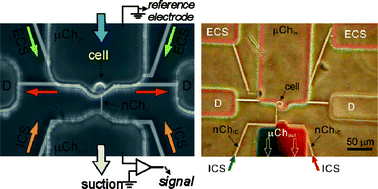Abstract
Ion channels play key roles in cell physiology and underlie a broad spectrum of disorders. To this day, the gold standard for studying ion channels is the patch clamp technique. Patch clamping involves careful positioning of a fine-tipped glass micropipette onto the surface of the cell to form a high-resistance (>1 GΩ) seal (“gigaseal”), a procedure that is laborious, vibration-sensitive, and not easily amenable to automation. In addition, the solution inside the pipette cannot be easily exchanged. Recently reported patch clamp chips offer the potential of increased throughput, but to date the overall per-cell performance of most designs has been very low when compared to pipettes, and/or the fabrication process is prohibitively expensive. Here we demonstrate a replica-molded elastomeric patch clamp chip incorporating nanofabricated constrictions, which delivers high-stability gigaseals, with success rates comparable to those of pipettes, using rat basophilic leukemia (RBL) cells. The high stability enables exchanges of both the extracellular and intracellular solution during whole-cell recordings. In a sample of 103 experiments, 66 cells (64%) were successfully immobilized at the patch aperture; 38 cells (58% of immobilized cells, 37% of all cells) were successfully gigasealed; and 25 cells (65% of gigasealed cells, 34% of immobilized cells, 24% of all cells) were successfully perforated for whole-cell access. In the last group of 27 experiments, 79% of the cells could be immobilized, of which 68% could be gigasealed and 46% perforated for whole-cell access, indicating that dexterity is important.


 Please wait while we load your content...
Please wait while we load your content...